If you’re planning on traveling to Naples and its surroundings, you may face the dilemma of whether to visit Pompeii or Herculaneum.
The two archaeological sites represent two of the most well-kept remains of ancient Roman settlements in Italy, and visiting at least one of them is essential for a trip that includes Naples and/or the Amalfi Coast.
Despite being similar in the fact that they were both Roman cities, you’d be surprised by the differences between Herculaneum and Pompeii!
And although there is an idea that Herculaneum is more worthwhile than Pompeii, the dilemma is not that easily settled.
From the architectural characteristics to the location, the time at your disposal, and a few other factors, here are some things to keep in mind before making your choice between Pompeii vs. Herculaneum.
But first, here’s a little historical background on these two famed ancient Italian Roman ruins, which can already hint at the difference between the two sites!
Table of Contents
A Brief History of Pompeii and Herculaneum
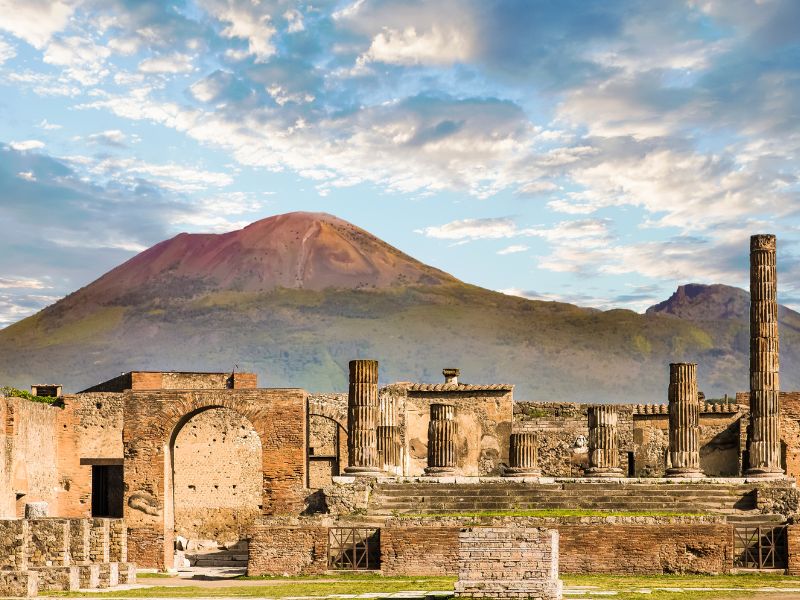
Both Pompeii and Herculaneum, as you may already know, were Roman cities.
However, their history dates further back to somewhere around the 8th century BCE, when Oscan-speaking people (who were the prehistoric inhabitants of Campania) lived in the area.
Between the 8th and 6th centuries BCE, Greeks and Etruscans contended for the cities and alternated hegemony until the two towns, alongside nearby Stabiae, were conquered by an Italian tribe called the Samnites.
Pompeii and Herculaneum thus became Roman municipia in 89 BCE, following the Social War when several Italian allies rebelled against the Roman Republic but were ultimately defeated.
In 62 CE, both cities were severely damaged by an earthquake. They still hadn’t fully recovered by 79 CE, the year that Mt. Vesuvius erupted in what remains one of the deadliest volcano eruptions in Europe.
For almost two millennia, it was thought the eruption took place on August 24, although recent discoveries place it in October the same year.
An eyewitness account of the events made it to our days in the form of two letters written by Pliny the Younger to the historian Tacitus.
The lawyer and author witnessed the eruption of the Vesuvius from the town of Misenum, across the Bay of Naples. His letters have been vital in reconstructing the events that took place nearly two millennia ago.
According to Pliny the Younger’s recounts, his uncle, Pliny the Elder, was in charge of a fleet stationed in Misenum when Mt. Vesuvius erupted. He launched a rescue party that he joined himself to rescue a friend.
While the fleet successfully returned to tell the tale, Pliny the Elder had died from asphyxiation caused by the volcanic toxic gases.
How Pompeii and Herculaneum Met Their End

Although Pompeii and Herculaneum were both destroyed in the same Vesuvius eruption, they suffered quite a different fate.
The way the destruction of the two cities took place had an impact on their conservation state. While Pompeii was destroyed slowly over the two days of the eruption, Herculaneum met an almost instant end.
The eruption of the Vesuvius in 79 CE happened in two phases. The first phase did not affect Herculaneum, despite being closer to the volcano, because of the winds blowing south-eastward. This eruption did, however, reach Pompeii.
In the first eruption, called Vesuvian or Plinian, a huge column of hot gases filled with volcanic rocks shot into the stratosphere and then rained down.
The wind carried all the debris that fell over Pompeii, destroying parts of the city and killing many people. Inhabitants of Herculaneum witnessed this eruption and started fleeing the city.
The second, more violent eruption consisted of a pyroclastic flow of hot gas and volcanic matter that flowed at high speed along the side of the volcano and into Herculaneum.
It is thought that the pyroclastic flow reached a temperature of 500 degrees Celsius, which instantly killed anyone in its way.
Herculaneum, therefore, was quickly covered in a layer of up to 25 meters of volcanic material that preserved the city almost intact.
Pompeii, on the other hand, which was further from the volcano, suffered slow destruction. The buildings were already partly destroyed by the first eruption, when another pyroclastic flow killed the last of the people remaining.
These different fates of the two cities explain why some areas of Herculaneum are better preserved than Pompeii.
How to Choose Between Pompeii vs. Herculaneum
Size: Pompeii is significantly bigger than Herculaneum — which is both a good and bad thing.
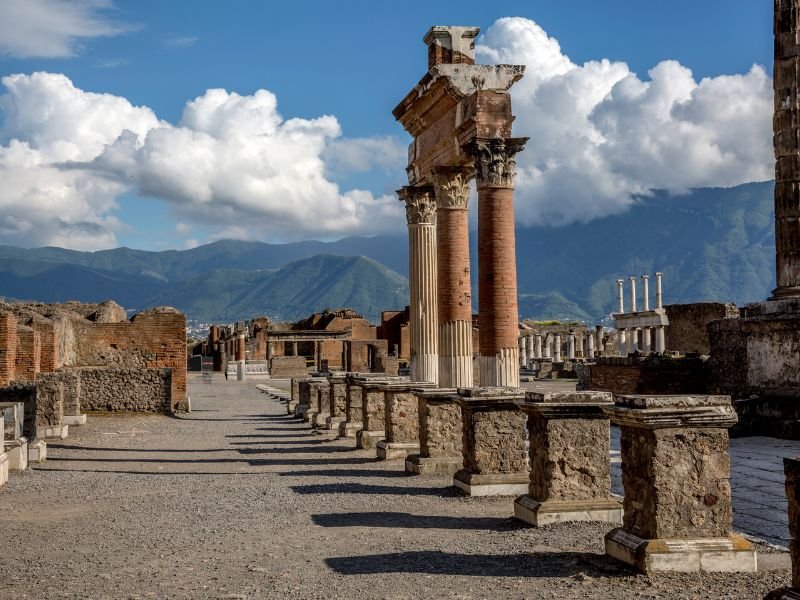
The first thing you may want to consider when making your choice is the size of the two archaeological sites.
The excavated area of Pompeii extends over nearly 110 acres (out of 170 total, which are still being worked on), while Herculaneum covers less than 50 acres.
Even back in the day, Pompeii had four times more inhabitants than Herculaneum and was a much more significant city.
Another reason for the big difference in size is that only 20% of Herculaneum is estimated to have been uncovered.
In Pompeii, nearly 70% of the ancient city has been excavated, though a third of the ancient city still lies under debris.
Before adventuring into your exploration, keep in mind that in Pompeii, you will need to walk… a lot.
You’ll be visiting an actual town, except in Pompeii every single thing is a landmark!
Even without stopping at every house and reading every plaque, you still need almost a full day (at least) to get a sense of Pompeii.
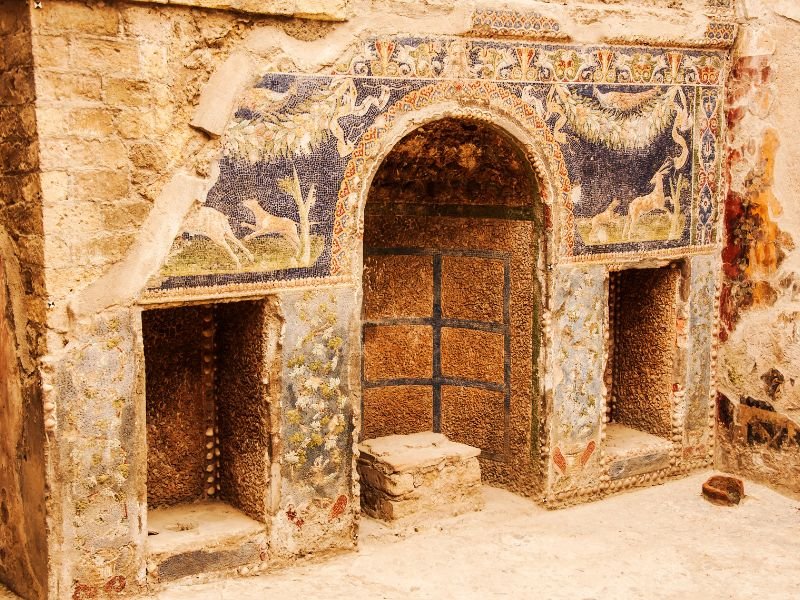
Herculaneum, on the other hand, is small and compact. Even if you’re tight on time, you can visit the entire site in a couple of hours and not miss any important landmarks.
Keep this information in mind also when it comes to your walking abilities. Are you prepared to walk several miles on uneven cobblestones and dirt roads?
If walking long distances poses an issue for you, Herculaneum may be a better choice.
Location: Are you visiting from Naples or Sorrento?
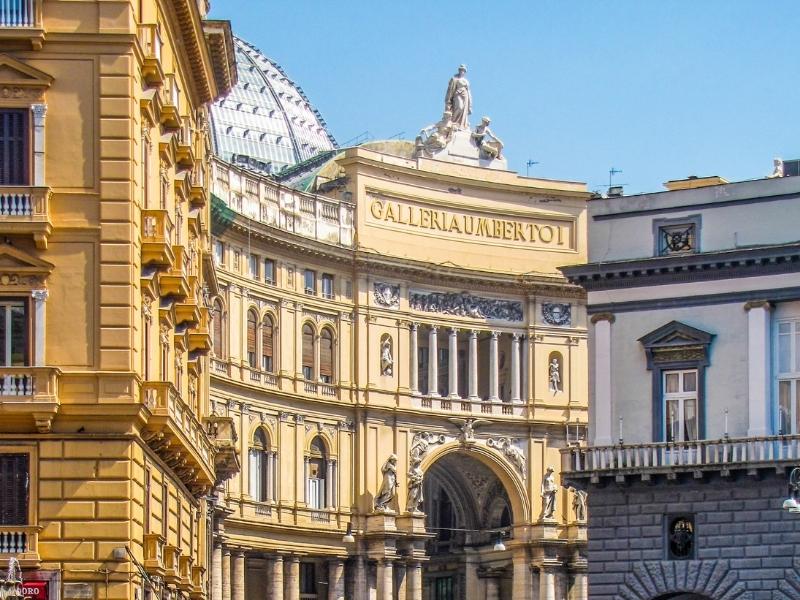
Another important factor to keep in mind is whether you are staying in Naples or Sorrento.
While both sites are quite easy to reach from both cities, Herculaneum is significantly closer to Naples, while Pompeii is closer to Sorrento and the Amalfi Coast towns.
The Circumvesuviana is a train line that connects Naples and Sorrento, running around the Vesuvius, hence the name.
The same train line stops at both Ercolano Scavi (the stop for Herculaneum) and Pompeii. However, being a commuter line, it stops several times along the way.
The train ride takes less than 20 minutes from Naples to Ercolano Scavi and roughly 40 minutes to Pompeii.
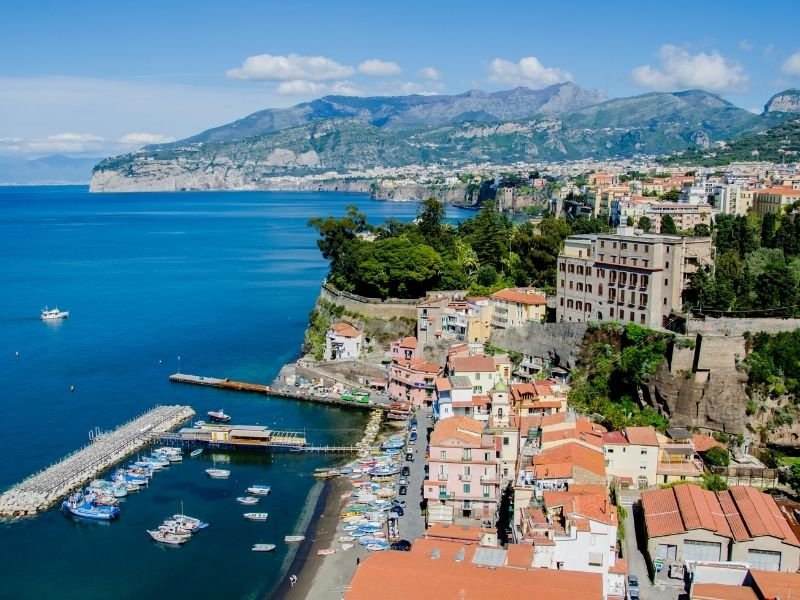
From Sorrento, you need almost one hour to reach Ercolano Scavi and roughly 35 minutes to get to Pompeii.
This isn’t necessarily the deciding factor, as it’s just an extra 20-30 minutes in each direction.
However, if you are visiting both Naples and Sorrento, you may want to plan your Herculaneum or Pompeii trip to better align with the trains.
Value: Where can you get the most value for money?

The difference in price between Herculaneum vs. Pompeii is minimal.
An adult entry ticket for Pompeii is 16€, while for Herculaneum it’s 13€.
If you are to look at the size of the sites, it appears obvious that in Pompeii, you get a bigger bang for your buck.
On the other hand, in Herculaneum, you get the chance to see some really well-preserved sites.
From entire two-story houses to beautiful frescoes and colorful mosaics, there are many sights that you only get to experience in Herculaneum!
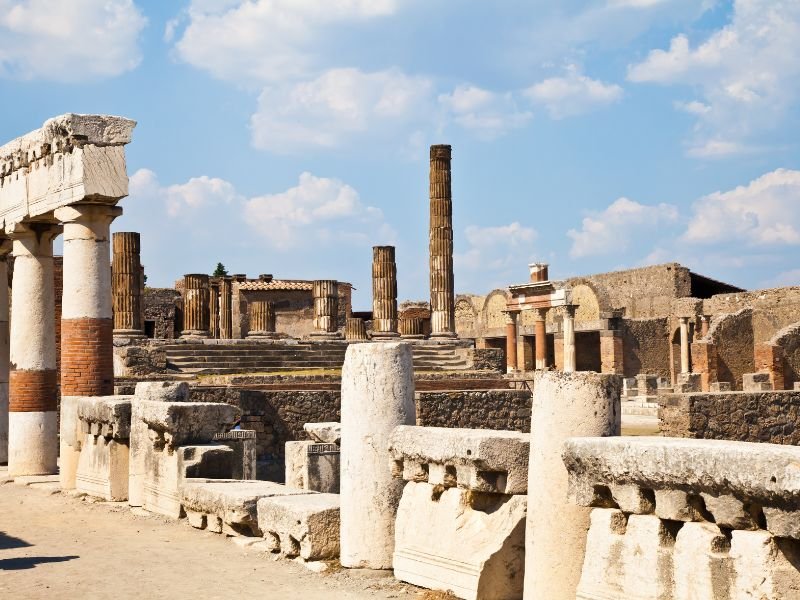
In Pompeii, there is the added bonus of visiting a truly famous site.
Although Herculaneum has gained popularity in recent years, Pompeii remains a must-see and one of the most impressive archaeological sites in the world…. and therefore, it is often quite crowded.
A little tip before you run to book your flights…. on the first Sunday of every month, you get the chance to visit both Pompeii and Herculaneum for free!
While it may be tough to squeeze both sites in one day, you can at least do one of them.
Just note that you still need a free visit ticket, and they may be restricted if too many people are visiting.
Season and crowds: Best time to visit each site to avoid the crowds
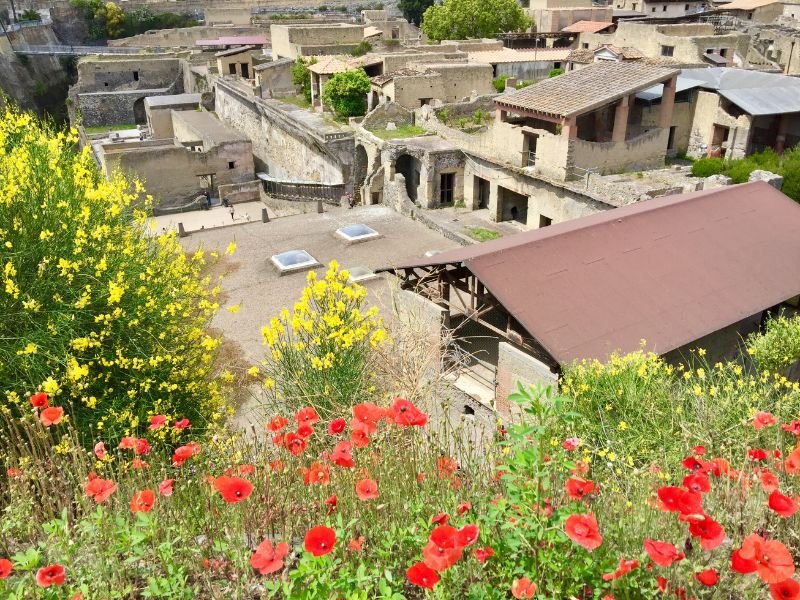
If you don’t mind walking around Pompeii in a river of people flooding the ancient streets, then this does not apply to you.
But if you’d like to stay away from big crowds, you need to consider a few things when picking Pompeii vs. Herculaneum.
First of all, Pompeii is by default more crowded than Herculaneum. While Herculaneum sees roughly 300,000 visitors per year, Pompeii opens its gates to over 2.5 million people every year… quite a difference!
However, there are better and worse times to visit the sites. Like most places all over Italy, it’s more likely for both Herculaneum and Pompeii to be more crowded during the summer months.
If you have no choice but to visit Italy in summer due to your vacation time availability, you will likely find Herculaneum to be less crowded than Pompeii.
If you want to have a shot at visiting a less crowded Pompeii, your best choice is winter, followed by early spring and late autumn.
Temperature: Where to go to stay away from the heat
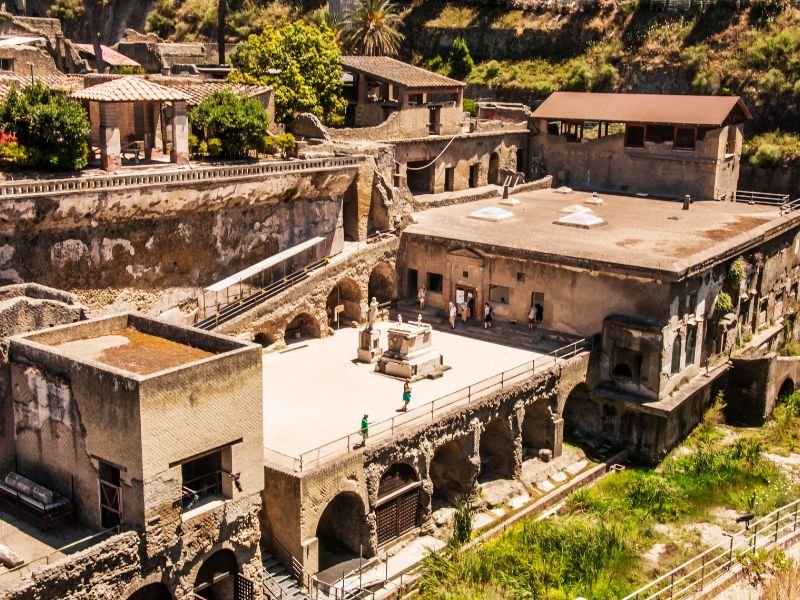
If you have ever been to southern Italy between June and September, you may know it can get unbearably hot.
Another reason to choose Herculaneum over Pompeii during summer is to escape (at least in part!) the heat.
Firstly, Herculaneum takes significantly less time to visit, so you will spend less time in the sun.
Secondly, this site has more shady spots.
Aside from being more compact, it also has two-story houses and well-preserved buildings that will give you many chances to hide from the sun.

On the other hand, Pompeii is extremely extensive and almost entirely exposed to the sun.
The vast majority of buildings don’t provide any shade, and you’ll find yourself walking through several big, open squares and spaces — often made worse by summer crowds.
Worse yet, the few shady spots will likely be overcrowded by many others looking to escape the heat.
Accessibility: Which is more accessible between Pompeii and Herculaneum?
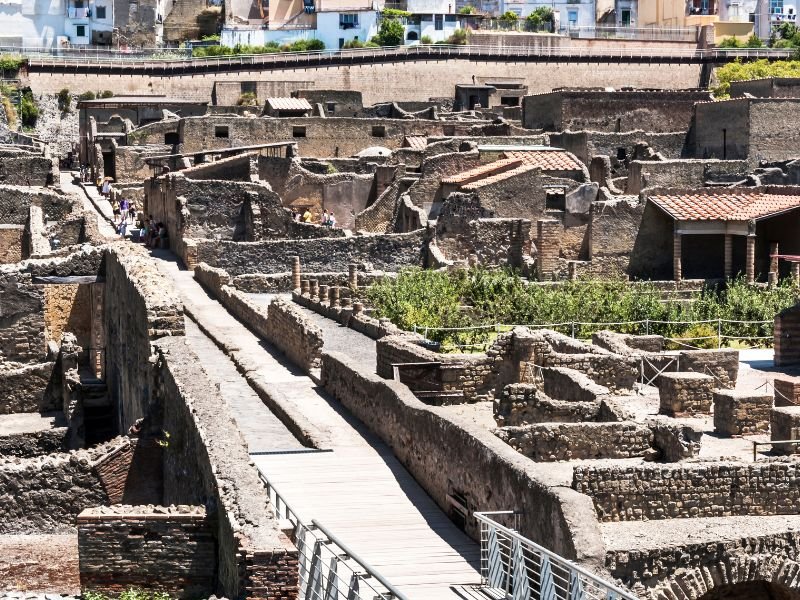
In recent years, work has done on both sites to make them accessible to everyone, including those with mobility limitations and access needs.
The Herculaneum site has been wheelchair-accessible since 2011 when the Herculaneum Conservation Project was completed.
People with mobility issues need to ask the staff at the entrance to gain access via a ramp, and there are other ramps throughout the site.
In Pompeii, not the entire site is accessible; however, an itinerary for people with reduced mobility was implemented under the project “Pompeii for All.”
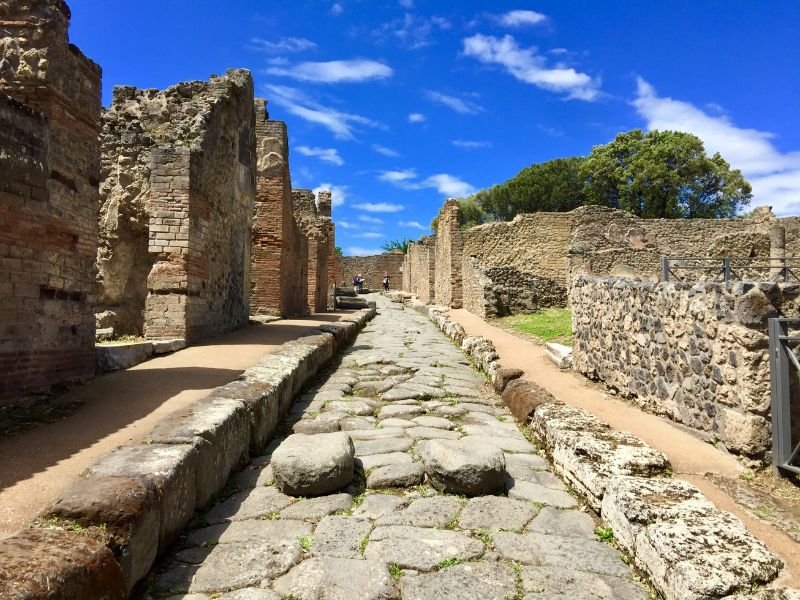
The itinerary covers 3.5 km from the entrance of Piazza Anfiteatro to the Sanctuary of Venus.
Visitors have the chance to access the most important buildings and enjoy the highlights of the ancient city, but not the extent of it.
Overall, simply due to the vastness of the site of Pompeii, it is probably easier for people with mobility issues to enjoy more of the sights in Herculaneum.
Sage Traveling, a blog that focuses on European travel accessibility for disabled travelers, gives Herculaneum 4 stars for its wheelchair accessibility vs. Pompeii’s 2 stars.
Uniqueness: A few things you can only see in Pompeii vs. Herculaneum
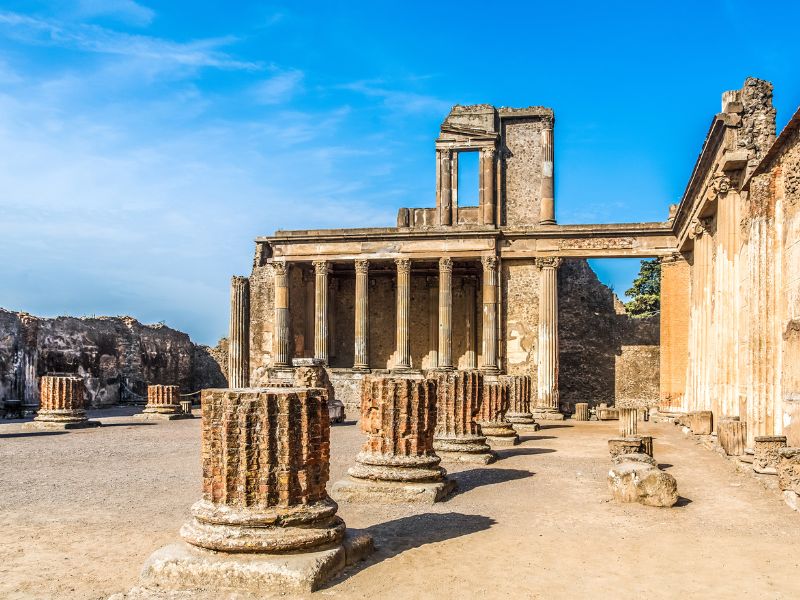
Pompeii has a few unique sights that you won’t find in Herculaneum.
If you want to see massive buildings, impressive villas, ancient brothels, wide squares, and striking body casts of people who lost their lives in the eruption, Pompeii is the place to go.
The Forum in Pompeii, once the main square in the city, is a wide space surrounded by typical Roman columns.
All around it, you will see temples, shrines, and other buildings. You won’t find such a space in the much smaller Herculaneum!
Furthermore, in Pompeii, you’ll see the impressive Amphitheater dating back to 80 BCE that used to seat 12,000 spectators.

The amphitheater is even older than the Colosseum in Rome and is very well-preserved.
The Villa of the Mysteries has an impressive colorful fresco that covers three walls and depicts an initiation rite into the cult of the god of wine, Dionysus.
Additionally, the House of the Faun is one of the biggest and most spectacular houses in Pompeii.
Other interesting places unique to Pompeii are the brothels, complete with, er, rather explicit mosaics… but not only that!
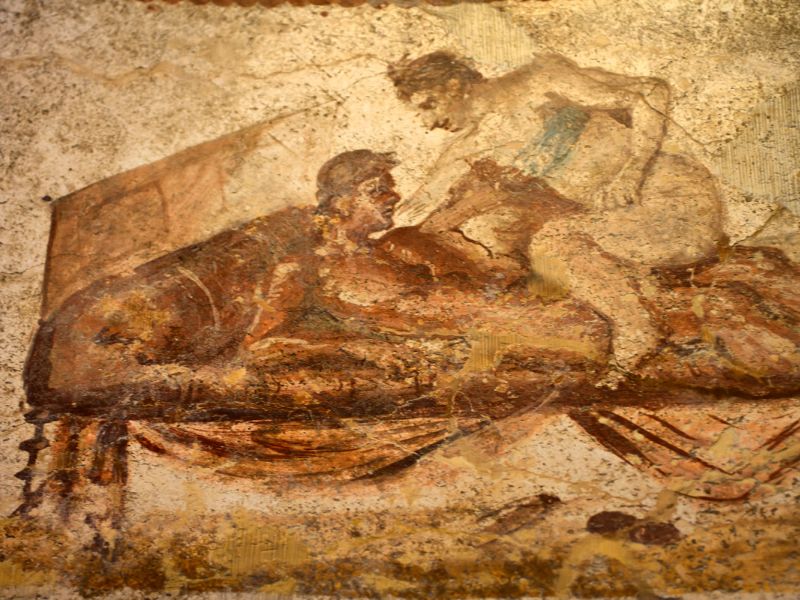
If you pay close attention (or get a guide to point them out), you’ll notice phallic symbols on the ground around town indicating the way to the nearest brothel!
Finally, in Pompeii, you can see the body casts of the victims of the eruption.
During the second eruption, people who remained in Pompeii got buried under layers of ash and rocks, their bodies still intact.
As the bodies decayed over time, the space that used to be taken up by their bodies left hollow spaces in between the volcanic debris.
In 1860, Giuseppe Fiorelli, the director of excavations, realized he could pour plaster into these spaces to reconstruct the bodies of the victims in the exact position they had when they died.
The result is quite a shocking sight of “bodies” in different positions as they were taking cover or trying to escape.

However, Herculaneum also has its own unique things you won’t get to see at Pompeii.
If you want to see nearly intact two-story houses and beautiful, well-preserved mosaics and frescoes dating back over two millennia, Herculaneum is where you should go!
The reason behind the art pieces being better preserved in Herculaneum is twofold.
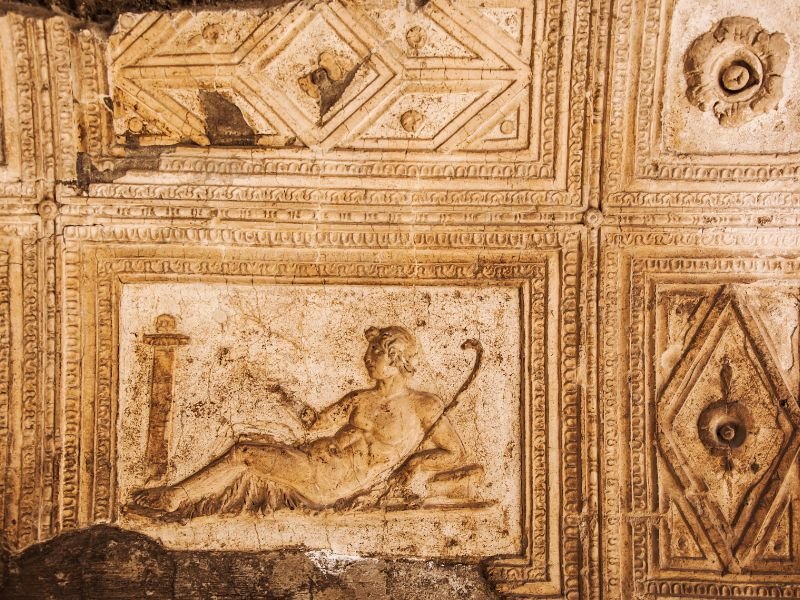
First, Herculaneum was buried under a much thicker layer of volcanic matter in a very short time, instantly freezing the city in time.
Secondly, excavations started later, meaning the mosaics and frescoes haven’t been exposed to the elements for so long.
In Herculaneum, you can admire the Sacello degli Augustali, a large square with a shrine dedicated to Hercules and many colorful frescoes of the divine hero and other Roman deities.
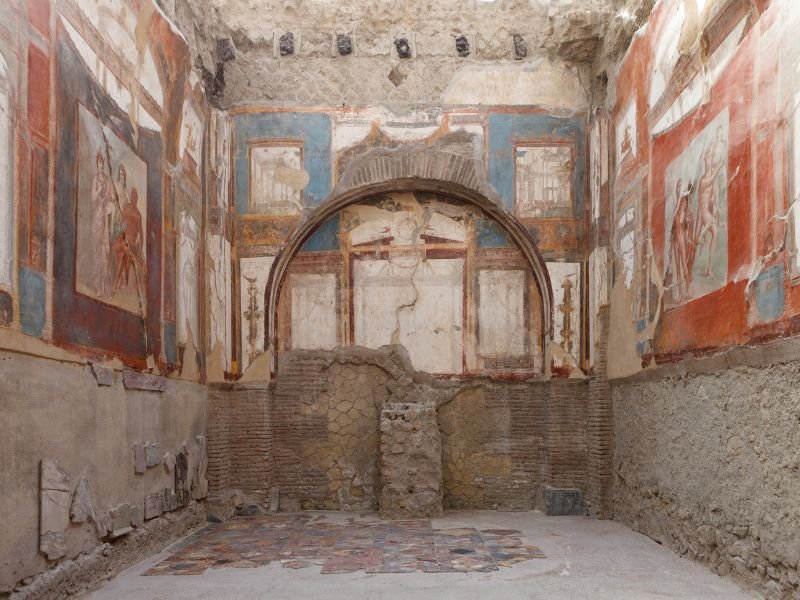
In the thermae (baths), you can see beautiful mosaics on the floor, while the House of the Neptune Mosaic, as the name suggests, has a glass wall mosaic of Neptune and Amphitrite.
Some of the most impressive and well-preserved houses in Herculaneum are the Villa of the Papyri, the Samnite House, and the House of the Wooden Partition.
Finally, as opposed to the plaster casts in Pompeii, Herculaneum has over 300 skeletons!
These were discovered in 1982, in boat sheds closer to the shore, likely as residents were attempting to flee.
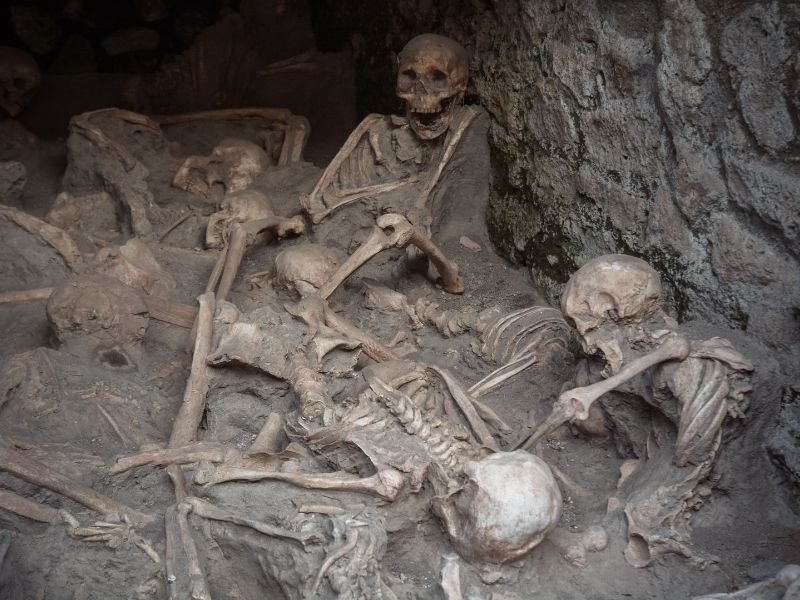
As opposed to the victims of Pompeii, who got buried under ash and rocks, the inhabitants of Herculaneum that did not manage to escape were incinerated by the pyroclastic flow.
All that was left were their skeletons — leaving behind quite an unsettlingly and spooky sight!
Best Way to Visit Pompeii and/or Herculaneum
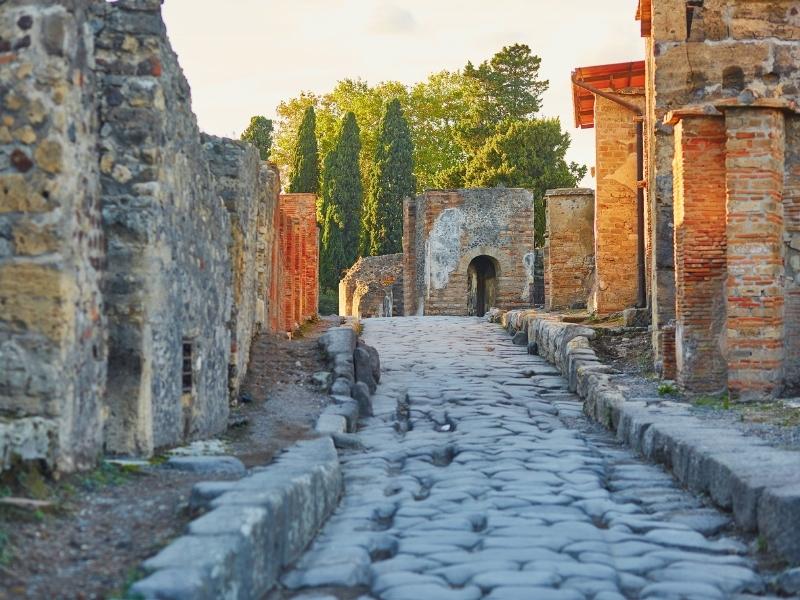
Having a guide — whether that’s an audio guide as you tour independently, or a licensed guide who leads a small group — is key to maximizing your experience, regardless of whether you visit Herculaneum or Pompeii.
The ruins are beautiful and the plaques are informative, but neither quite capture the rich history and culture that these two important ancient Roman cities embodied.
Luckily, there are guides available at a variety of price points, so it doesn’t have to be too expensive to add this important historical context and guidance to your experience!
Visiting Pompeii
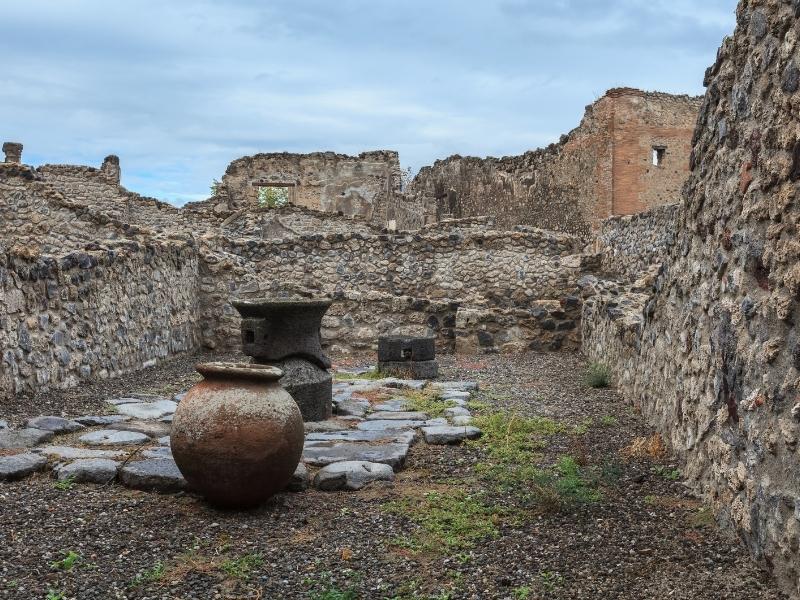
If after reading this, you choose to visit Pompeii, there are several ways to obtain a guide.
The most popular option is to take a full-day guided tour of Pompeii and Vesuvius.
This tour departs from Naples, includes roundtrip transportation, a licensed guide for the entire day, lunch, and entry tickets to both Pompeii and Mt. Vesuvius (a combined €26 value).
Note: This tour is similar in terms of price inclusions, but also has the option to depart from Sorrento.
If you want to save money, the cheapest option is to go by train from Naples/Sorrento to Pompeii, and then enter with a skip-the-line ticket with audio guide included.
If you’re very comfortable taking public transportation while abroad and prefer to view sites at your own leisure, this is definitely the better alternative.
Visiting Herculaneum

Similar to the above tour, you can visit Herculaneum as a day trip from Naples, with transfer, archaeologist guide, and entrance fee included (lunch is not included).
Note: This tour doesn’t include Mt. Vesuvius so if you want to see that as well, a combo tour of Pompeii and Vesusius may be a better option.
The most affordable way to visit Herculaneum is to arrive there by train and then meet your licensed guide upon arrival.
This tour includes skip-the-line tickets to Herculaneum as well as a two-hour small group guided tour with an actual archaeologist!
If you don’t want to go with a guide, you can simply pre-book your entry ticket to skip the line.
Is it Worth Visiting Both Pompeii and Herculaneum?
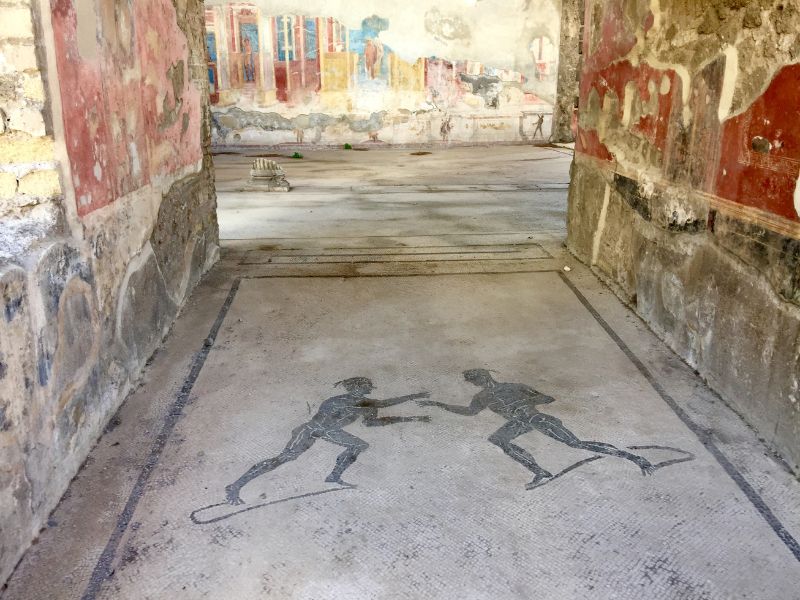
The short answer is yes — so long as you’re a fan of history!
While you may think that visiting one site is enough because they are so similar, as you can see, there are quite a few unique features to each of them.
If you are short on time, choose the best option for you considering all the logistical details, as well as the sights you would like to see.
But if you have plenty of time or you are returning to southern Italy after having already seen one site, it’s worth visiting the other.
Finally, although it is possible to visit both sites in one day and breeze through them at a quick pace, visiting on two separate days is a better idea to reduce ‘museum fatigue’ and keep your sense of wonder alive.

Roxana is a Romanian-born freelance travel writer who has lived in Italy for over 15 years. She has a Master’s in Journalism and a Bachelor’s in Film Studies, and she studied at Università degli Studi di Roma Tre. Besides her native Romania, Roxana has lived in Rome, Lisbon, and Berlin, and she has traveled through much of Europe in search of hidden gems, history, and culture.